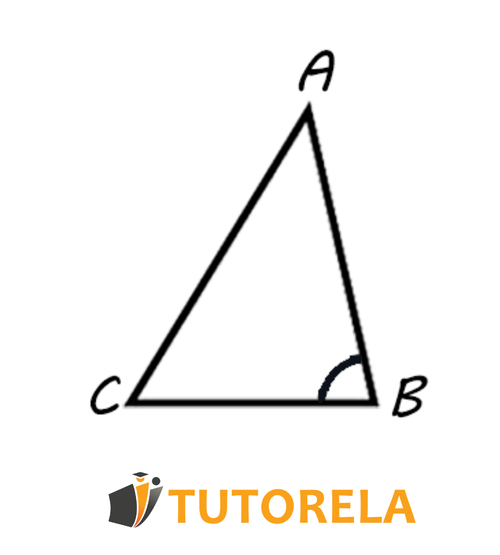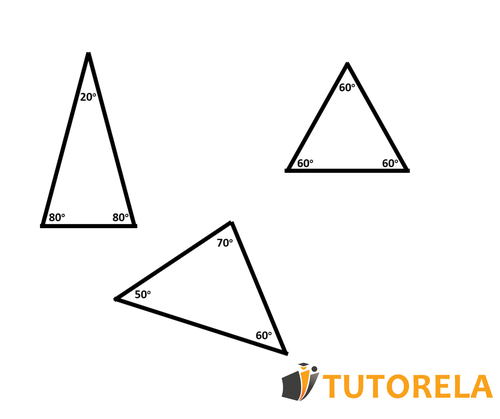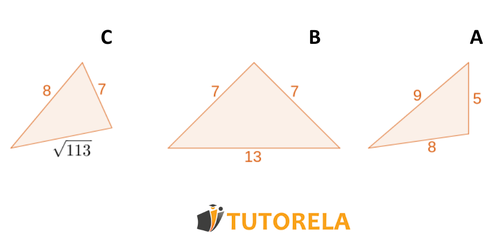An acute triangle has all acute angles, meaning each of its three angles measures less than degrees and the sum of all three together equals degrees.
Acute triangle
Test yourself on types of triangles!
What kid of triangle is given in the drawing?
Next, we will look at some examples of acute triangles:
Acute triangle

3 Examples of acute triangles

Exercises with Acute Triangles
Exercise 1

Assignment:
Determine which of the following triangles is obtuse, which is acute, and which is a right triangle:
Solution:
A. We will examine if the Pythagorean theorem holds for this triangle:
The sum of the squares of the perpendicular sides is greater than the square of the remaining side, therefore it is an acute-angled triangle.
B. Now we will examine this triangle:
The sum of the squares of the perpendicular sides is greater than the square of the remaining side, therefore it is an obtuse-angled triangle.
C. The longest side of the 3 will be treated as the hypotenuse.
The Pythagorean theorem holds true and therefore triangle 3 is a right triangle.
Answer:
A-acute angle acute B-obtuse angle obtuse C-right angle right.
What kind of triangle is given in the drawing?
What kid of triangle is the following
What kind of triangle is given in the drawing?
Exercise 2
Let's look at 3 angles
Angle A is equal to
Angle B is equal to
Angle C is equal to
Task:
Can these angles form a triangle?
Solution:
The sum of the angles in a triangle is equal to ,
therefore these angles can form a triangle.
Answer:
Yes, since the sum of the internal angles of a triangle is equal to .
Exercise 3
Angle A is equal to
Angle B is equal to
Angle C is equal to
Task:
Can these angles form a triangle?
Solution:
The sum of the angles is greater than ,
therefore these angles cannot form a triangle.
Answer:
No, since the sum of the internal angles must be , and in this case the angles add up to .
Examples and exercises with solutions for acute triangles
Exercise #1
What kid of triangle is given in the drawing?
Video Solution
Step-by-Step Solution
The measure of angle C is 90°, therefore it is a right angle.
If one of the angles of the triangle is right, it is a right triangle.
Answer
Right triangle
Exercise #2
What kind of triangle is given in the drawing?
Video Solution
Step-by-Step Solution
As all the angles of a triangle are less than 90° and the sum of the angles of a triangle equals 180°:
The triangle is isosceles.
Answer
Isosceles triangle
Exercise #3
What kid of triangle is the following
Video Solution
Step-by-Step Solution
Given that in an obtuse triangle it is enough for one of the angles to be greater than 90°, and in the given triangle we have an angle C greater than 90°,
Furthermore, the sum of the angles of the given triangle is 180 degrees so it is indeed a triangle:
The triangle is obtuse.
Answer
Obtuse Triangle
Exercise #4
What kind of triangle is given in the drawing?
Video Solution
Step-by-Step Solution
Given that sides AB and AC are both equal to 9, which means that the legs of the triangle are equal and the base BC is equal to 5,
Therefore, the triangle is isosceles.
Answer
Isosceles triangle
Exercise #5
Which kind of triangle is given in the drawing?
Video Solution
Step-by-Step Solution
As we know that sides AB, BC, and CA are all equal to 6,
All are equal to each other and, therefore, the triangle is equilateral.
Answer
Equilateral triangle
Which kind of triangle is given in the drawing?
What kind of triangle is given here?
Calculate the size of angle X given that the triangle is equilateral.
More Questions
Types of Triangles
- Parallel Line Geometry: Classifying Triangle ABC with Extended Side AE
- Right Triangle Area Problem: Solve for X When Area = 6 cm²
- Square Diagonal Properties: Classifying Triangles ABC and ACD
- Isosceles Triangle ABC with Parallel Line ED: Investigating Triangle Properties
- Triangle Classification: Identifying a Shape with Three 60° Angles
- Area
- Trapezoids
- Area of a trapezoid
- Perimeter of a trapezoid
- Parallelogram
- The area of a parallelogram: what is it and how is it calculated?
- Perimeter of a Parallelogram
- Kite
- Area of a Deltoid (Kite)
- Congruent Triangles
- Angles In Parallel Lines
- Alternate angles
- Corresponding angles
- Collateral angles
- Vertically Opposite Angles
- Adjacent angles
- The Pythagorean Theorem
- Elements of the circumference
- Circle
- Diameter
- Pi
- Area of a circle
- The Circumference of a Circle
- The Center of a Circle
- Radius
- How is the radius calculated using its circumference?
- Rectangle
- Calculating the Area of a Rectangle
- The perimeter of the rectangle
- Congruent Rectangles
- The sides or edges of a triangle
- Similarity of Triangles and Polygons
- Triangle similarity criteria
- Triangle Height
- Midsegment
- Midsegment of a triangle
- The Sum of the Interior Angles of a Triangle
- Exterior angles of a triangle
- Relationships Between Angles and Sides of the Triangle
- Relations Between The Sides of a Triangle
- Rhombus, kite, or diamond?
- The Area of a Rhombus
- Perimeter
- Triangle
- The Area of a Triangle
- Area of a right triangle
- Area of Isosceles Triangles
- Area of a Scalene Triangle
- Area of Equilateral Triangles
- Perimeter of a triangle
- Right Triangular Prism
- Bases of the Right Triangular Prism
- The lateral faces of the prism
- Lateral Edges of a Prism
- Height of a Prism
- The volume of the prism
- Surface area of triangular prisms
- Areas of Polygons for 7th Grade
- Area of a right-angled trapezoid
- Area of an isosceles trapezoid
- Corresponding exterior angles
- Alternate interior angles
- Median in a triangle
- Center of a Triangle - The Centroid - The Intersection Point of Medians
- How do we calculate the area of complex shapes?
- How to calculate the area of a triangle using trigonometry?
- How do we calculate the perimeter of polygons?
- All terms in triangle calculation
- Parts of a Circle









